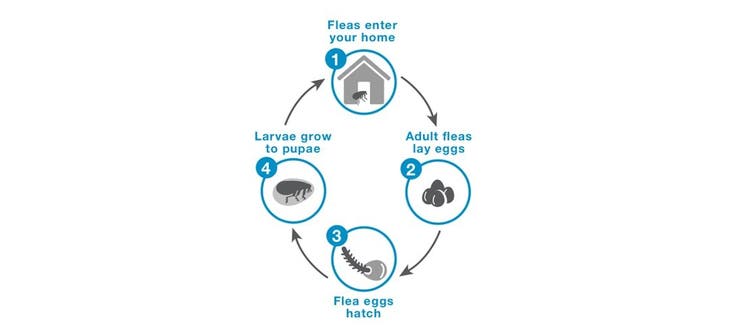Learn how to break the flea life cycle.
Spotting just one flea on your dog or cat can signal a huge problem. A few fleas can quickly become hundreds that may infest your home and bite your pet. Humans can only see adult fleas, so it’s understandable if you tend to focus your treatment efforts on them. But as you’re killing adult fleas, the younger stages of fleas are growing in the surrounding environment. Adult fleas make up only 5% of the total flea infestation problem — the other 95% are invisible to the naked eye.1 A regular flea protection plan could save you time and money, and could help bring you peace of mind.
Credelio Quattro™ (lotilaner, moxidectin, praziquantel, and pyrantel chewable tablets), is a once-monthly chewable tablet for dogs, that protects against fleas as well as five additional parasites, such as tapeworms. By understanding the four stages of the flea life cycle and adopting a treatment plan, you could help put a stop to expensive and time-consuming flea infestations. Let’s explore.
The 4 Stages of the Flea Life Cycle
Stage 1: Flea Eggs
A single flea can lay up to 50 eggs in one day.2 As your pet moves around, flea eggs disperse into the surroundings, including carpet, bedding and the backyard.
Stage 2: Flea Larvae
Flea larvae hatch from eggs in one to 10 days. Treating adult fleas with a product like Credelio Quattro is your first step, but understanding how to kill flea larvae effectively is also important. You will need to thoroughly vacuum and wash areas of your home, and maintain your yard. Flea larvae feed on organic debris, don’t like sunlight and live in moist, dark areas, such as:
- In Carpeting
- Under furniture
- Under baseboards
- In bedding
- In shaded areas of your yard
Stage 3: Flea Pupae
Larvae turn into pupae by enclosing themselves in a sticky, silk‐like cocoon. They usually emerge as adult fleas one to two weeks later, but can stay in their cocoons for weeks or months waiting for a host — like your dog or cat — to live on.
Stage 4: Adult Fleas on Your Dog or Cat
You can see fully grown fleas with the naked eye, and they begin biting almost immediately after getting onto your pet. Contrary to popular belief, fleas neither jump from pet to pet nor fly because they do not have wings. They stay on one pet biting, feeding and laying eggs for up to several months.
If a flea cannot find a dog or cat to jump on, it’s not uncommon for them to jump on and bite people. This is why some people experience flea infestations and flea bites after returning from vacation or moving into a new house.
What Does Flea Larvae Look Like? What About Flea Pupae and Adult Fleas?
Flea larvae look like tiny worms. They are so small that it’s rare to spot one. Flea pupae are hidden inside a cocoon and can be easily mistaken as lint or dirt. Adult fleas are dark red or brown, wingless, thin and flat.
The Flea Life Cycle: Time Considerations
Remember, a single flea can lay up to 50 eggs in one day, making a fast-acting treatment plan essential. Credelio Quattro kills 100% of fleas within 12 hours of administration and remains effective for an entire month.3
Flea Protection for Dogs
Killing adult fleas helps break the flea life cycle and prevent fleas from biting your dog. That’s why it’s important to use a product that both treats and prevents fleas.
Credelio Quattro works in two ways:
- It kills the adult fleas on your dog.
- It breaks the flea life cycle by killing adult fleas before they lay eggs.
Administering Oral Flea Medication for Dogs
Credelio Quattro protects dogs with broad parasite protection and convenience than competing brands by protecting dogs from fleas and five additional parasites in the form of a one-dose, flavored chewable tablet. It’s an allergy-friendly, meat-free formulation4 that’s easy to give to dogs as young as eight weeks, and it’s available in five weight classes.
Breaking the Flea Cycle and Providing Worm Protection for Dogs in One Product
Credelio Quattro starts killing fleas and ticks within four hours. Just one monthly Credelio Quattro chewable provides 100% protection against heartworm disease, and treats and controls multiple species of tapeworms, plus roundworms and hookworms.
Avoiding and treating fleas doesn’t have to feel overwhelming. Credelio Quattro (lotilaner, moxidectin, praziquantel, and pyrantel chewable tablets) works fast against fleas while offering the broadest parasite protection of its kind*.
1. Dryden MW. Host association, on-host longevity and egg production of Ctenocephalides felis felis. Vet Parasitol. 1989;34:117-22
2. Grace SF. Fleas. In: Norsworthy GD, Crystal MA, Grace SF, et al, eds. (2006). The Feline Patient. 3rd ed. Ames, IA: Blackwell Publishing; 106-107.
3. Cavalleri D, Murphy M, Seewald W et al. Assessment of the speed of flea kill of lotilaner (Credelio™) throughout the month following oral administration to dogs. Parasite Vectors 2017;10(1):529
4. Elanco Animal Health. Data on File.
*Based on label comparison of the number of parasite types covered in a chewable that also targets ticks.
Indications for Credelio Quattro
Credelio Quattro is indicated for the prevention of heartworm disease and the treatment and control of roundworm, hookworm, and tapeworm infections. Credelio Quattro kills adult fleas and is indicated for the treatment and prevention of flea infestations and the treatment and control of tick infestations for 1 month in dogs and puppies 8 weeks of age and older and weighing 3.3 pounds or greater. Credelio Quattro is indicated for the prevention of Lyme disease infections as a direct result of killing black-legged ticks.
Important Safety Information for Credelio Quattro
Lotilaner, an ingredient in Credelio Quattro, belongs to the isoxazoline class and has been associated with neurologic adverse reactions like tremors, ataxia, and seizures even in dogs without a history of seizures. Use with caution in dogs with a history of seizures or neurologic disorders. Dogs should be tested for existing heartworm infections before Credelio Quattro administration as it is not effective against adult D. immitis. The safe use in breeding, pregnant, or lactating dogs has not been evaluated. The most frequently reported adverse reactions in clinical trials were vomiting and diarrhea. For complete safety information, please see the Credelio Quattro product label or ask your veterinarian.




